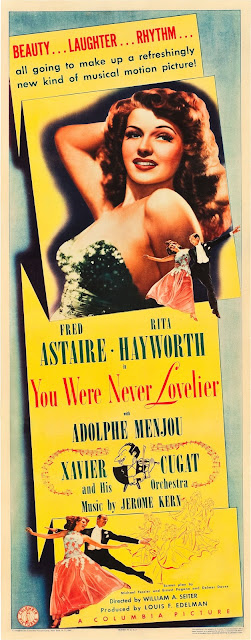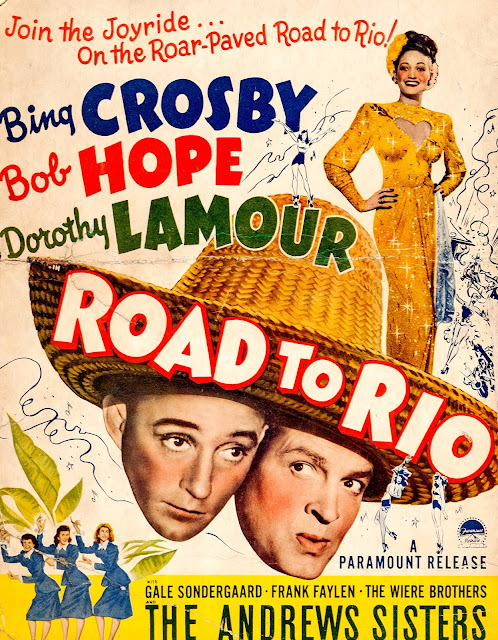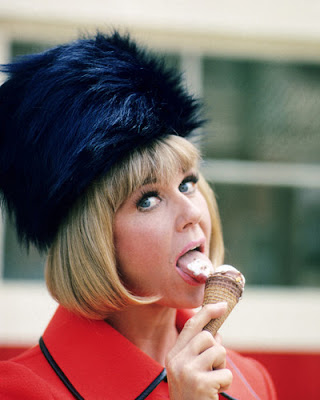Powell and Pressburger entrance with... The Tales of Hoffmann (1951)
Deservedly praised for their delectable Technicolor creations and thought-provoking stories, Michael Powell and Emeric Pressburger are a film lover's dream team. Tales of obsession have never been portrayed so beautifully and so bitterly, as evidenced by the likes of The Red Shoes, Black Narcissus, A Matter of Life and Death, and more. I'm always awed by Powell and Pressburger, so when I saw the opportunity to participate in a blogathon celebrating British films, I knew I wanted to write about one of their movies. But which one? I confess that The Red Shoes is my favorite from the twosome, but for months their 1951 collaboration The Tales of Hoffmann has been sitting in my DVR, just begging for me to watch it. Like Hoffman himself, I can't deny the calling of a good story.
After filming the ballet sequence to end all ballet sequences in The Red Shoes, Michael Powell was interested in creating what he called a "composed film," essentially a filmed opera. And that's what The Tales of Hoffmann is: 136 minutes of opera. Now, I'm not the biggest fan of the art form, and I'm sure I'm not the only one there, but I tell you what, if all productions looked like this film, I would go to the opera any chance I could. The great thing about Tales is it acknowledges its theatricality, but it also maintains subtleties and filmic tricks that you wouldn't find in the theater. Close-ups reveal facial expressions that wouldn't be noticeable unless blown up on a screen; wax candles become shiny jewels in the blink of an eye; a reflection in a mirror disappears without a trace.
As its title says, Tales of Hoffmann is comprised of three stories of three different lovers experienced by the poet E.T.A Hoffmann (Robert Rounseville). The framing device is that Hoffman is currently in love with the gorgeous Stella (Moira Shearer), a ballet dancer whose performance Hoffmann is watching. During the show's intermission, everyone goes to Luther's Cellar and ask Hoffmann to tell them stories instead of going back to the show. Each vignette is set up like an individual piece, with a book appearing
before each segment that introduces the characters and the real actors that are playing them, much like you would see at a real opera. This can make you forget that these stories are told from the perspective of Hoffmann, which is important to remember in order to truly understand what's being presented to you. For example, in the poet's present, his rival for Stella's affections is Councillor Lindorf (the marvelous Robert Helpmann), so whenever there is a villain in his stories, the guy just happens to look exactly like Lindorf. When it comes to examining the four women Hoffmann talks about, it's especially imperative to remember that we are seeing them through his lens, which begets dislike of Hoffmann in my case. Let me explain...
The first woman we meet is Stella, whom Hoffmann describes as "three women blended as one: true artist, tender maiden, and courtesan." As the film goes on, you realize that Hoffmann's past loves were each of these things, so he believes that Stella symbolizes the ultimate combination of his lovers, which probably explains his attraction to her (not to take anything away from Stella). Unfortunately for Hoffmann, he forsakes Stella by getting drunk and recollecting other women instead of meeting up with her after the show, allowing Lindorf to swoop in and take Stella away, leaving Hoffmann stoned and alone by film's end. So, who are these women that still seem to have a hold on the man?
After filming the ballet sequence to end all ballet sequences in The Red Shoes, Michael Powell was interested in creating what he called a "composed film," essentially a filmed opera. And that's what The Tales of Hoffmann is: 136 minutes of opera. Now, I'm not the biggest fan of the art form, and I'm sure I'm not the only one there, but I tell you what, if all productions looked like this film, I would go to the opera any chance I could. The great thing about Tales is it acknowledges its theatricality, but it also maintains subtleties and filmic tricks that you wouldn't find in the theater. Close-ups reveal facial expressions that wouldn't be noticeable unless blown up on a screen; wax candles become shiny jewels in the blink of an eye; a reflection in a mirror disappears without a trace.
As its title says, Tales of Hoffmann is comprised of three stories of three different lovers experienced by the poet E.T.A Hoffmann (Robert Rounseville). The framing device is that Hoffman is currently in love with the gorgeous Stella (Moira Shearer), a ballet dancer whose performance Hoffmann is watching. During the show's intermission, everyone goes to Luther's Cellar and ask Hoffmann to tell them stories instead of going back to the show. Each vignette is set up like an individual piece, with a book appearing
before each segment that introduces the characters and the real actors that are playing them, much like you would see at a real opera. This can make you forget that these stories are told from the perspective of Hoffmann, which is important to remember in order to truly understand what's being presented to you. For example, in the poet's present, his rival for Stella's affections is Councillor Lindorf (the marvelous Robert Helpmann), so whenever there is a villain in his stories, the guy just happens to look exactly like Lindorf. When it comes to examining the four women Hoffmann talks about, it's especially imperative to remember that we are seeing them through his lens, which begets dislike of Hoffmann in my case. Let me explain...
The first woman we meet is Stella, whom Hoffmann describes as "three women blended as one: true artist, tender maiden, and courtesan." As the film goes on, you realize that Hoffmann's past loves were each of these things, so he believes that Stella symbolizes the ultimate combination of his lovers, which probably explains his attraction to her (not to take anything away from Stella). Unfortunately for Hoffmann, he forsakes Stella by getting drunk and recollecting other women instead of meeting up with her after the show, allowing Lindorf to swoop in and take Stella away, leaving Hoffmann stoned and alone by film's end. So, who are these women that still seem to have a hold on the man?
First is the "tender maiden," Olympia (Shearer again). Unbeknownst to Hoffmann, Olympia is the creation of scientist Spalanzani (Léonide Massine) and magician Coppelius (Helpmann)--that's right, she's a living doll. This segment is amusing because Hoffmann is so utterly clueless about the girl he's fallen in love with, thanks to Coppelius and his henchman (Frederick Ashton) distracting him whenever they need to wind up Olympia. It's quite a cruel trick, culminating in one of the most
horrifying things I've ever seen. Angry that Coppelius bought his share of the business with a rubber check, Spalanzani demands Olympia, leading to the two men pulling her in opposite directions until she's completely dismembered. I will never be able to get the image of Moira Shearer being pulled apart out of my mind, particularly the part where her head is lying on the floor. her eyes are fluttering and making clicking sounds, and springs pop out of her to demonstrate to Hoffmann that she was indeed an automaton. Some of this segment can be seen here, which sadly jumps around and doesn't show the whole thing unedited, including the "death" of Olympia. Finding clips for Tales of Hoffmann is really hard, I must say.
The next story is, in my opinion, the best of the bunch. It's the tale of the courtesan, the beautiful Giulietta (Ludmilla Tchérina), a heartless woman who makes men fall for her so she can steal their souls for her true love, Dapertutto (Helpmann, looking fierce). The beginning is absolutely enchanting as Giulietta and Dapertutto lounge in a gondola, singing the very pretty "Barcarolle." Giulietta's image in mirrored in the shimmering water, allowing for her voice to be doubled. It's quite romantic, not just this moment
but the whole vignette. Hoffmann is entranced by Giulietta and believes that she loves him, but once his reflection disappears from the mirror, a sign of his soul departing, his illusions are shattered. The unfortunate thing is that he just killed a man because of the courtesan. Before Hoffmann, Giulietta was fooling around with Schlemil (Massine), whose jealousy over Hoffmann goads him into challenging the poet to a duel. This swordfight is a marvel of editing and rhythm, the cuts of the film perfectly in sync with the music while still offering excitement and a sense of brutality, the synchronization only ending when Hoffmann delivers the fatal blow. I had to watch this scene three times, and each time I found myself saying out loud "Wow!" You can watch the first five minutes of Giulietta's tale here, which unfortunately leaves out a lot, including the duel.
The third and last story is about Antonia (Ann Ayars), an opera singer who has consumption, thus crippling her career. Yes, it's one of those "she'll die if she does what she loves!" deals. Antonia has all sorts of problems: she can't sing, which makes her feel like she's let her dead mother down because she was a great singer, and as if that wasn't bad enough, her father forces her to stay home. Apparently an old family friend, Hoffmann visits with Antonia and promises to take her away after learning
about her claustrophobic surroundings. Antonia is ecstatic, until the terrifying Dr. Miracle (Helpmann) pops up. The doctor and his monstrous widow's peak try to entice Antonia back into singing, using her mother to do it. It's all very shady and kind of typical, but then Dr. Miracle really sparks my interest. Antonia is content with just being a housewife for Hoffmann, but the doctor tells her she's so much more than that: "What kind of love from such a lover? / For Hoffmann's made you the victim to excite his brutal desire / Only your beauty feeds his fire...his passion for you will expire." Damn, Dr. Miracle, way to hit the nail right on the head. Antonia actually listens to him and realizes why, yes, she does want a fabulous career. Of course, it helps that the image of her mother appears and they have a weird supernatural reunion. Antonia is so happy, she sings and promptly dies.
So, let's see, we have a doll controlled and torn apart by men, a woman exploited for her sexuality and used by a man, and a delicate flower who dies a saint. Considering we're viewing these women as Hoffmann does, I think it's safe to say we're not getting the whole truth. For one thing, how do we know that Giulietta didn't ignore Hoffmann despite his advances, so he made her image suffer by painting her as evil? And what about Antonia--did Hoffmann "kill" her off because she chose a career over being a housewife? Granted, the stories are clearly fictional and fantastical, but that doesn't make the female characterizations any less troubling. Hoffmann is a storyteller, and how he chose to represent women only perpetuates stereotypes, not to mention the Madonna/whore complex.
Another interesting thing of note is the persistent fragmenting of the women. Giulietta is doubled with her reflection in the water; Antonia is practically a duplicate of her mother, who "reappears" through the trickery of Dr. Miracle; Olympia is literally ripped into bits and pieces; and Stella at the end is shown as four women, reiterating Hoffmann's claim that she is more than one woman. Importantly, although Hoffmann said she was three women, the filmmakers show her as four,
acknowledging that she is her own woman. We seem to get little time with Stella in comparison with the other women and the majority of time spent with her places us with Hoffmann, as we watch Stella perform in the ballet. Her solo piece is interesting, though, because she portrays a dragonfly who interacts with a male dragonfly until she triumphantly decides to be on her own and literally walks into the sunlight. After seeing Hoffmann's stories and Lindorf leading Stella away, you get the sense that Stella will eventually realize that she's better off without either man. Or maybe that's just my hope.
With Hoffmann falling in love with a different woman every second, it seems like the only person who is safe is his best friend, Nicklaus (Pamela Brown). Despite the masculine name, Nicklaus is a woman, albeit a very androgynous one. Perhaps this is why Hoffmann never considers her a romantic target, or maybe he sees her as an equal, unlike his other conquests. It's hard to tell when Nicklaus is literally relegated to the shadows and corners of the film. The camera will pan to her from time to time to show she's irritated with Hoffmann's romantic failures; she also consoles him after his disastrous run-in with Giulietta. Nicklaus is very much a riddle to me. How did she and Hoffmann meet? Why does she stay around? Does she love him, or is it strictly platonic? Does she have anyone else in her life besides Hoffmann?
As was popular with Hollywood films at this time, no one uses their actual singing voice except for Rounseville (Hoffman) and Ann Ayars (Antonia). The rest of the cast was dubbed, and you can find a list of those singers here. Frederick Ashton, the man who frequently played small parts in each segment as a henchman of some sort, had been a mentor of Moira Shearer's for years. He also choreographed the film, which was based on Jacques Offenbach's last opera, also titled The Tales of Hoffmann. The part of Stella was originally a singer, but because Shearer was cast, the character became a dancer. I'm actually quite fascinated with Moira. She only did six films, and preferred the stage over Hollywood. The Red Shoes was her movie debut--can you imagine? I absolutely love her and wish she did so much more. Retired from ballet by 1953, Shearer continued to act, including a final collaboration with Powell on the infamous Peeping Tom in 1960. Seeing her name attached to a film instantly makes me want to see it. (By the way, if any of you know how I can get my hands on a Region 1 disc of The Man Who Loved Redheads, or where I can find it online, I would be eternally grateful.)
The Tales of Hoffmann is a gorgeous and thoughtful film. It lacks the warmth and passion of many of Powell and Pressburger's pictures, but you'll still find yourself enchanted. The technical ingenuity, the colors, the highly-stylized sets, and the delightful trio of Moira Shearer, Léonide Massine, and Robert Helpmann are sure to keep you interested.
 |
| Helpmann in the first of many moments where he looks more fabulous than I ever will. |
 |
| Look at Leonide Massine! I need this on my wall. |
 |
| Giulietta's singing reflection. |
 |
| Notice the absence of Hoffmann's reflection, and excuse the bad quality of the photo. |
 |
| Just because I wanted to give you all nightmares. |
 |
| Antonia reuniting with her "mother". |
 |
| "Three women blended as one" |
 |
| Lindorf leading Stella away with his bedazzled cape. Seriously, guys. I'm so jealous of Helpmann in this movie. |
With love,
Michaela
*********************************************************************************
This post is part of the second British Invaders blogathon, hosted by A Shroud of Thoughts. To see the rest of the great roster, click here.







































Great post! I think it's a fantastic piece of cinema - no surprise from The Archers - but whether it works as a film ... just about, IMO. I haven't seen it in a while but Helpmann in particular is seared on my brain; easily the equal of The Childcatcher from Chitty Chitty Bang Bang. You also picked some great screencaps!
ReplyDeleteI've not seen the opera, so I looked it up on Wikipedia - apparently Nicklauss isn't the real Nicklauss but the Muse of Poetry in disguise, trying to make Hoffmann focus on poetry and not get distracted. I'll have to dig the DVD out to see if that makes sense!
Robert Helpmann is unforgettable in everything he does -- I'm sure many a child would attest to that after seeing Chitty Chitty Bang Bang. I loved taking those screencaps, for sure.
DeleteNicklaus as the muse would make sense! I don't think the film clarifies that, and I read a few other articles after I posted mine, but no one mentioned it. It would explain why Nicklaus is always like "Here we go again" when a pretty girl shows up, and why she's always with Hoffmann. Thanks for telling me this, you've given me food for thought!
This film looks gorgeous! (But of course it does, being a P&P film.) I knew nothing about it before reading your post – now I can't wait to see it!
ReplyDeleteI'm afraid my photos don't do the film's beauty justice! It's quite an interesting flick. It may not be another Red Shoes or Black Narcissus, but it doesn't deserve the anonymity it's gotten either. I hope you get to see it soon!
DeleteThanks for stopping by!